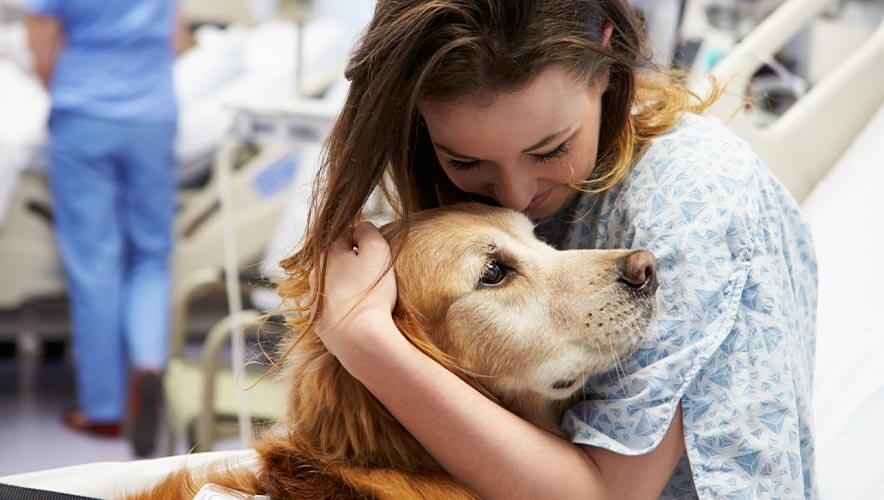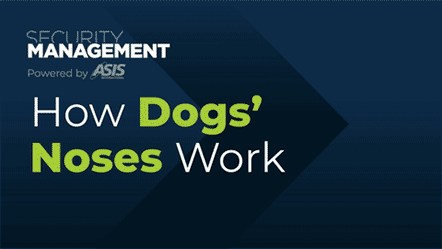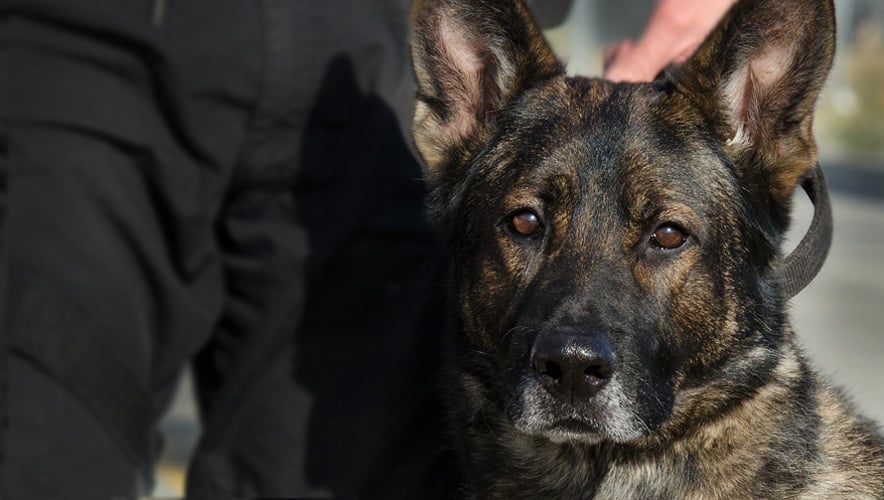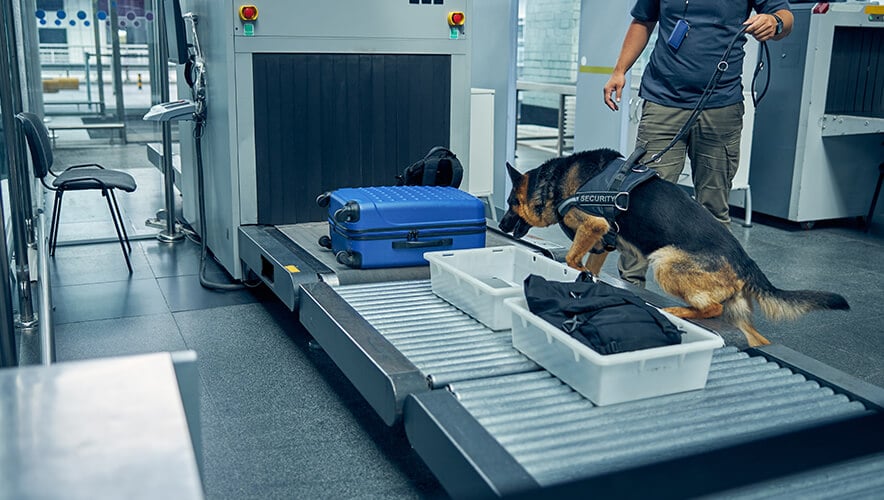Security’s Best Friend: How K9s Detect, Deter, and De-escalate
Human beings can seem like the only species working in security. Sure, a rat in the security operations center might chew a wire, a deer meandering near the perimeter fence might trip an alarm, or a bird might be getting a little too close to aircraft on a tarmac. But by and large, security usually means people defending against the actions of other people. Technology has helped with those challenges over the years, but digital tools come and go. Over the centuries, one living technology has remained steadfast.
Dogs have been bred, domesticated, and employed to protect property, sniff out criminals and contraband, and get dangerous individuals to think twice about starting trouble. These animals’ work has often been centered on local, state, and federal law enforcement, with city K9 patrol units, state search dogs, and federal airport drug and explosives-detection dogs. However, private security professionals also have been putting them to work for a long time.
Where Hounds and Hospitals Fit Together
The private sector has been cautious about the unfamiliarity and cost of K9 units, according to Craig Plante. He spent years trying to talk former law enforcement bosses into using working dogs after he saw what a difference they made at a previous job in the Connecticut Department of Corrections.
Plante would watch from afar as the K9 handlers and their dogs would make prisoners wary. The dogs’ presence seemed to cut down on fights and riots.
“When something jumps off, fights break up with just the K9 guy showing up,” Plante says. A prisoner thinking about attacking a guard wouldn’t do it if there was a risk of being bitten by the officer’s dog. The dogs also routinely sniffed out contraband in the prison, from drugs to mobile phones.
In addition to making prisoners rethink their behavior, the K9 program seemed to inspire improved performance in the department. There was something about the way that prison K9 program was run that helped “growth and excellence start to shine through,” he says.
“In a 20-year career, I never saw the K9 unit stagnate,” Plante adds.
After Plante changed sectors to lead security at a series of hospitals and medical facilities in the Hartford HealthCare Group in Connecticut, he advocated for the organization to add to its single K9 unit for patrols and detection. Once they agreed, Plante’s program expanded. He was appointed public safety K9 program manager for the entire hospital chain. Plante still works every day with his detection and patrol dog, Remi, but he now also oversees work to systematize how K9 units are trained and used in Hartford’s hospitals.
Back in 2021, when Plante and Remi joined the only other Hartford HealthCare K9 team—Nicholas Stokke and another former bomb-detection dog, Nitro—the two teams would do everything: patrolling parking lots and lobbies, visiting medical wards, and even sniffing around loading docks, helipads and warehouses containing medical supplies. Today, the K9 program has grown to eight K9 units across the healthcare chain’s 500+ facilities, with dedicated teams for some of the largest facilities.
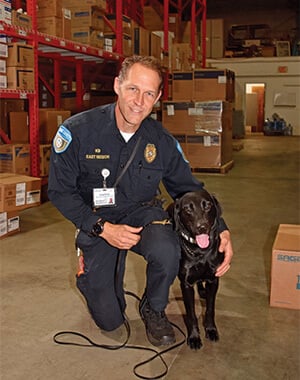
Hartford HealthCare Public Safety K9 Supervisor Craig Plante poses with detection and patrol dog Remi. Photo courtesy of Craig Plante; Hartford HealthCare.
Unlike prisons, military bases, or police stations, hospitals are “very soft targets,” Plante says, and he’s convinced that the dogs’ presence deters potential criminals. His favorite example is hard to prove, but he sees it regularly: Patients or guests walk into a hospital waiting area, see the dog, and “give themselves the fake pat down," as Plante describes it. The visitor may have forgotten something in his or her vehicle, or he or she might be going back to put away their drugs, knife, or gun because of noticing the K9 and security officer team.
“When people make up their mind to do something, I don’t want them to do it on our hospital campus,” he says. In tense situations, people who are angry and screaming may continue “running their mouth,” he says, but usually stop physically acting out when a dog is present.
The appearance and breed of K9 affects the response people have. Plante’s dog, Remi, is a floppy-eared, approachable black Labrador, which tends to put people at ease. Other dogs might elicit a different reaction.
“With pointy-eared dogs, people have been trained to think they can bite, but our dogs aren’t patrol dogs trained for that,” Plante says.
While Plante says that Hartford HealthCare hospital leadership is extremely happy with the program, he is also sensitive to the fact that, while he has ample insight into the work his dogs do each day, he can't necessarily point to qualitative data like suspects arrested or numbers of weapons or pounds of drugs confiscated. The dogs’ greatest success may be deterrence, which is notoriously difficult to prove.
That’s why Plante has instituted a more robust report-writing protocol to better log what happens during shifts. He’s experimenting with ways to compile that information to show success, if not in pounds of heroin or numbers of convictions, then busy, productive days helping customers—whether hospital employees, patients, or their families.
“I feel like 80 percent of our success is just [people changing their behavior] in the presence of the dog,” Plante says.
Of course, sometimes drugs really are seized. Six months ago, a patient in one facility had unprescribed fentanyl, but he wouldn’t hand it over to staff before getting treatment.
“Our canine and handler came around the corner in the hallway, and he gave everything up,” Plante says. “That’s what we want. K9 units can help de-escalate situations and get contraband without putting hands on people.”
In that particular case, the K9 unit didn’t need to detect a thing. But for many security professionals, the dogs’ best quality is the ability to prevent crime by detecting people and substances.
Taking a Bite Out of Crime Prevention
During the few past few decades, the world has awakened to the global risk of terrorism. That’s why Dale Buckner, CEO of security firm Global Guardian, says dogs have been employed more and more by world governments, security agencies, and his other clients. In the event of special events or special venues, if local law enforcement doesn’t have K9 resources to put in place, clients may turn to private security for their K9 detection and patrol needs.
“Dogs are a niche part, but a powerful part, of counterterrorism,” Buckner says.
The use of K9s is most visible in “every single major airport in the world,” he says, where handlers are marching dogs through passenger areas and behind the scenes in luggage sorting areas to find weapons, drugs, or explosives that have snuck past other security measures.
Global Guardian is asked to bring those capabilities to locations and events for clients. Dogs are used for a variety of situations around vehicles, buildings, and larger areas. They act in security and patrol, explosives and narcotics detection, and tracking. These settings can range from workplaces and schools to businesses, houses of worship, and sports venues.
Dogs are a niche part, but a powerful part, of counterterrorism.
At the University of Southern Mississippi’s National Center for Spectator Sports Safety and Security (NCS4), Director of Training and Exercise Daniel Ward says K9 units are particularly ideal for venues with multiple access points and large open spaces. Put simply, the dogs notice things that people can miss. In addition, they serve as an ideal security measure to deter criminals as well as act as an alternative to security professionals’ firearms.
“Think of dogs as the most wonderful nonlethal means of addressing an intruder,” Buckner says. Yes, some dogs can be trained to kill, but most are ideal for running at, catching, biting, and incapacitating people without seriously injuring them or leading to a lethal encounter.
Ariel Kern, Global Guardian’s vice president of international affairs, calls dogs a “force multiplier” for law enforcement and security. “Many people are used to guns. They are not used to dogs and the fear of getting bit,” he says.
Buckner says the superior odor detection and psychological advantage dogs bring to the table make them increasingly common at big events: “They’ve become the standard of protection for sporting events, Taylor Swift-size concerts, and events with high-end CEOs.”
Buckner adds that this time-tested method of security and protection holds its own alongside the highest levels of security technology. For example, Kern says, an uncrewed aerial device or drone can fly over a cargo ship and monitor for intrusions or other issues; however, a well-trained, odor-detecting K9 can sniff through cargo containers loaded with tons of coffee to find a single kilogram of heroin.
How Dogs Are Deployed in Private Security
Not every dog could sniff out that kilogram of contraband, though; working dogs are not interchangeable. Floppy-eared breeds like pointers or Labradors fit in well among the public or have been bred for different skills over the years. Meanwhile, bigger, more aggressive pointy-eared breeds, such as German, Belgian, or Dutch shepherds, tend to be more intimidating. Kern says that even within a breed, not every dog is created equal and not every dog can be trained for every job.
Bryan Miller, director of canine operations at GardaWorld Federal Services, agrees, which is why the company has narrowed down the best breeds for their clients. “German shepherds, Belgian Malinois, Dutch shepherds, Labrador retrievers, and German shorthaired pointers are the breeds that work best,” he says.
Miller says that the dogs come from breeders that the company trusts and that each dog needs to show “a balance between drive and the ability to learn, retain information, and develop in a timely manner.” At GardaWorld, these dogs are eventually deployed for a variety of government, military, and commercial uses, from screening at events to explosives detection in open areas and closed rooms, and around vehicles and bags.
So, what are the biggest differences between so-called floppy-eared and pointy-eared breeds?
“Pointy-eared breeds are more versatile, as you can use them for detection and as a deterrent,” Kern says. “However, pointy-eared dogs can put guests on edge in a way that a floppy-eared doesn’t.”
Crowd size affects dogs’ suitability, too. “Some dogs are more attentive, nervy, and useful for military K9 units, with a high drive,” Kern says. “But with too many people around, those dogs get stressed, and you may want a more docile dog.”
Stacey West, the program manager for the Patriotic Puppy Program of the American Kennel Club (AKC)—which connects breeders of explosive detection dogs with law enforcement, military, and security professionals who need them—agrees. You need the right dog for the right job. West says that while pointy-eared breeds are perfectly good at both odor detection and patrol and security, it’s about what’s right for the venue.
“A sporting breed like a Labrador retriever doesn’t get the same psychological response as a German shepherd or Belgian Malinois because those breeds have a reputation,” West says. It makes sense to put an intimidating Belgian Malinois at the point of entry and security checkpoints, he says, but a Labrador retriever detecting drugs or explosives can mix among a crowd of 60,000 at an NFL game and doesn’t stress customers, just the nervous “bad guys.”
“You want a layered approach,” West says. At a public event, the uniformed handler stands at the metal detection station, but the floppy-eared sporting breeds mix in the crowds and in the parking lots.
Kern agrees: “We ask every client, before picking dogs, exactly what will be contraband for that location or event.” The reason: Jurisdictional restrictions matter as much as the impression you want the working dog to give. Even if something is legal in the area, do the event organizers want it on the premises? Is alcohol forbidden? Is marijuana out? Are guns allowed? Explosives, weapons, drugs, and other contraband-sniffing dogs are trained on specific odors to maximize their effectiveness on the job.
How to Train Your K9
Nobody knows the exact percentage of difference, but it seems as if more dogs destined for security in the United States are imported from Europe than bred stateside. Kern says that the European dogs’ gene pools have longer lineages, and for many generations these dogs have been selected for aggression, trainability, and odor detection.
Breeding for working dogs differs from breeding for a good-looking example of the breed. They might both be German shepherds, but a dog with pristine AKC traits that’s ready to win a show is not necessarily a dog selected through generations to be ready to search, bite on command, or sniff out odors.
Even those with the best noses, however, can’t be trained on everything. Different talents and temperaments exist in the same litter, even. Kern has trained a brother on drug detection and his littermate sister on explosives. “They’re both successful at their individual task, but the behaviors they need are different,” he says.
For instance, a dog sniffing for the odor of explosives may need to stay controlled and on leash, remain calm, and lie down to alert a handler who remains at some distance from an odor. Handlers do not want that explosives dog to prematurely set off devices or alert a person in possession of an explosive.
On the other end of the spectrum, another dog of the same breed may be looking for drugs or contraband at an event or poking around in the baggage sorting area of an airport. That handler may want to give the K9 free rein to roam off leash and is less worried about the danger of it sniffing around specific bags at close proximity.
These desired behaviors are trained over months and years by the dogs’ trainers and eventually their handlers. Rules about what, if any, certification is needed often comes down to the program and the organization’s needs. K9 handlers in law enforcement may be called to court to testify about what a dog detected and will need to prove to a judge that the dog is properly trained.
West says that many of the standards that permeate these odor-detection dog programs and associations came from the work in 2010 of the Scientific Working Group on Dog and Orthogonal Detector Guidelines (SWGDOG) sponsored by the U.S. Department of Justice’s National Institute of Justice. Organizations like the United States Police Canine Association, the North American Police Work Dog Association, and the National Association of Security Dog Users may recertify annually. Handlers retrain dogs daily by exposing them to specific environments and rewarding them upon successful detection.
Kern says working dogs he receives from European breeders have often been left to “run wild” as puppies in their first year, developing their hunting drive and learning some basic commands, but not being trained for highly specific environments or work. That comes later, when a dog has matured. Then the dog’s handler works in the right places with the right visual stimuli, the right commands, and the right rewards to make that dog and its handler successful.
Don Slavik, the executive director of the United States Police Canine Association, started working with K9 units way back in 1976 with the St. Paul Police Department in Minnesota, and he continued on with the Bureau of Alcohol, Tobacco, Firearms, and Explosives. Slavik says he’s been glad to see K9 training improve over the decades, particularly due to innovations in understanding how dogs learn.
“We now know that the dog learns more things than we thought,” Slavik says. Once upon a time, handlers didn’t know their dogs were as bright as they are—that they pick up not just on odors but also the environments in which those odors are found.
“Dogs are context-specific, so it’s the behavior we’re training and the environment we’re training in,” he says. Training should be scenario-based and ongoing.
New insights into canine learning have also meant a switch from positive punishment (giving a dog an unfavorable consequence to discourage undesirable behaviors) to positive reinforcement (where dogs receive rewards for desirable behaviors). One meta-study in the Journal of Veterinary Behavior found that “positive reinforcement carries less risk of negative unintended outcomes.”
“Positive punishment can be controversial,” Slavik says. “It may lead to undesired side effects, such as fear and aggression.”
Even with positive reinforcement techniques, handlers still need to be careful about how attentive dogs are, because they will pick up on the slightest cues from handlers on how to get a treat and try to create a shortcut.
“A dog sees you moving to reach for a ball in your pocket before you think they do,” Slavik says.
Hartford HealthCare’s Plante says he trained for eight weeks with his floppy-eared, odor-detecting Remi, retired from her first career as a bomb-detection dog. Plante gets his dogs for the Hartford program from a retired police sergeant in Connecticut, who both seeks out the right dog for what Plante’s department needs and then handles its initial training.
“By the time we get a dog, he’s already vetted it and done three to five weeks of training," Plante says. “Then we put the dog through environmental training, so they’re exposed to buildings, crowds, elevators, tile floors, and loud noises.”
K9 units can help de-escalate situations and get contraband without putting hands on people.
All that canine training is important, but the human handler’s education is just as crucial. Global Guardian’s Kern says that even an experienced handler still needs to train closely with a new dog, because every dog is different.
“A great handler learns to read that dog’s signals correctly,” he says. Human beings show attentiveness, exhaustion, stress, and focus in different ways. Dogs are the same.
Slavik says handlers learn to watch the dog and think about how the dog sees, hears, and smells. For instance, a search dog may sit down and alert to an odor in front of a wall: Where’s the suspect? It can turn out that the HVAC system is blowing air down in front of the wall from another location in the building. In other words, handlers need to think about not just where a dog is looking but where odors may be coming from in a particular environment.
“When you track downwind, you walk right by a hidden person before the dog gets a scent,” Slavik says. “A handler has to understand all that.”
How to Get Started with K9s in Security
If you are looking at your organization and thinking that K9 units could have a place in your security plan, the best place to start is by reaching out to your network, according to the K9 handlers Security Management spoke to.
Consider colleagues you know who are protecting assets or detecting contraband with K9 units. Figuring out where you can pick good team members to be handlers, find well-bred working dogs, train those dogs, and deploy those dogs is going to be unique to your situation. Learn from others’ favorite sources for training and breeding.
“A good K9 handler has a lot of patience,” Kern says. Is that you, or another dog-loving, animal-attuned coworker on staff? Or could that handler be a new hire with potential?
The work of a K9 handler requires constant training and retraining for both the dog and the handler, according to Hartford HealthCare’s Plante: “My right-hand man [Stokke] is open to criticism and mentoring, and as he’s trained more, he’s taken on field training of other K9 units in our hospital system.”
Another of Plante’s K9 handlers, Rich Sipala, struggled initially with his dog.
“We joked with him, ‘You got a feral dog,’ ” Plante says. “I told him to hang in there, you’re going to crack it.”
The dog struggled with “environmentals”—context-based training in busy areas, to practice staying calm and focused. But Plante says Sipala showed “stick-to-itiveness and was willing to be comfortable with being uncomfortable as [he and the dog] became a better team. … And now, months later, we’ve got this awesome dog and a fantastic handler.”
Another crucial step in exploring the possibilities in K9 security is reaching out to experts in the field, according to Plante. When researching and setting up his current program, Plante turned to his old contacts in the K9 units of the Connecticut Department of Corrections. Depending on the organization’s goals for a dog’s role and a handler’s experience level, security teams may be months or years out from a robust, successful program. Patience is required from both handlers and organizations.
Of course, there’s always the risk that a dog that’s healthy and happy to work can be sidelined by the law. For example, in U.S. states where marijuana use is legalized, dogs trained to detect marijuana have to be retired from other types of security work or be extensively retrained. But a good working dog, without serious illness or injury, may put in a solid six to eight years before retiring to the handler’s home, so that initial patience can pay off in the form of long, productive years from security’s new best friend.
Brendan Howard is host of the monthly podcast Security Management Highlights from ASIS International. He has been working in publishing and multimedia for nearly 25 years.
Additional reporting by Megan Gates, senior editor for Security Management.


